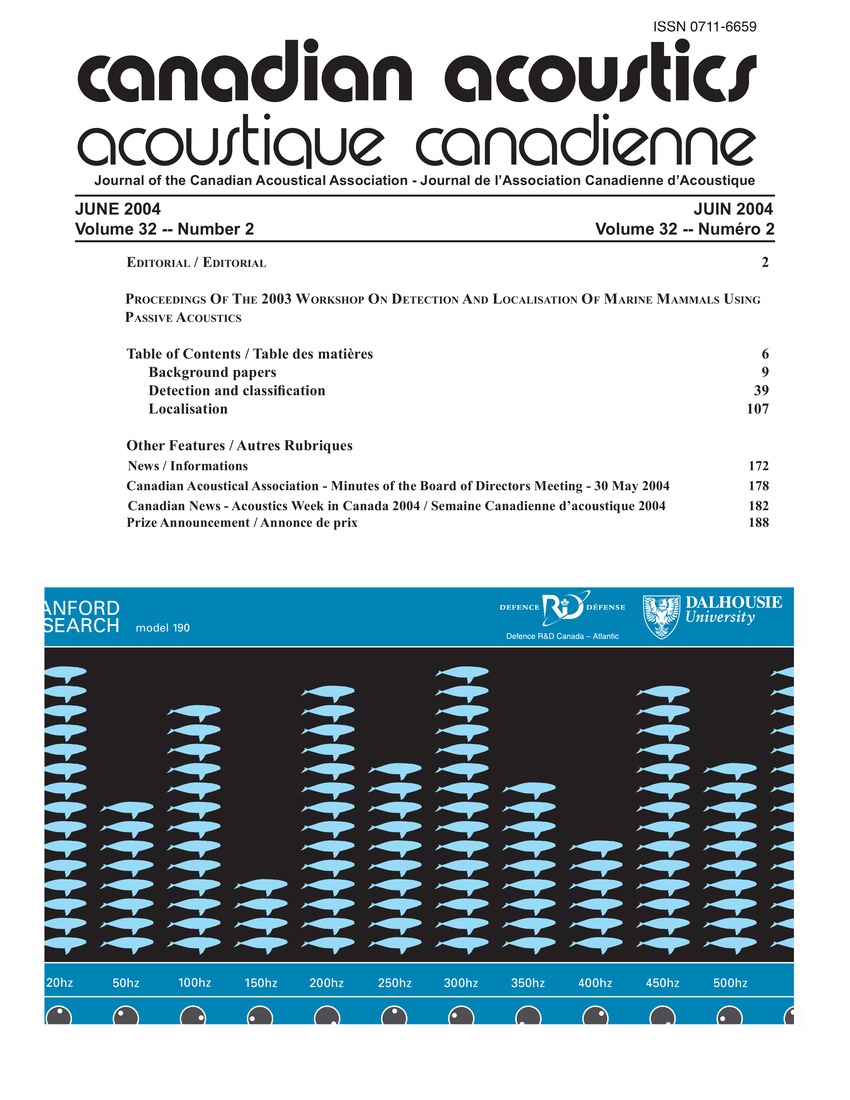Waveguide propagation allows range estimates for north pacific right whales in the bering sea
Mots-clés :
Acoustic waves, Modal analysis, Parameter estimation, Sediments, Waveform analysis, Waveguides, Acoustic recording, Sediment density, Waveguide propagation, WhalesRésumé
L’eau peu profonde et uniforme de la rive Est de la mer de Béring produit un excellent guide d’ondes acoustiques. Dans ce guide de propagation, la dispersion des ondes sonores est dépendante de la distance. Nous présentons ici un moyen pour utiliser la dispersion des ondes sonores pour déterminer la portée de sons émis par des baleines à partir d’un unique instrument d’enregistrement du signal acoustique. La vocalisation prédominante de la baleine franche du Pacifique Nord (Eubalaena japonica) est une modulation ascendante d’environ 90 à 160 Hz et d’une durée approximative de 1 s. La bathymétrie régionale de la rive Est de la mer de Béring est relativement uniforme et peu profonde (~70 m de profondeur). Cette géométrie fournit un guide d’ondes à couches horizontales ou les vocalisations modulées de baleines franches peuvent être détectées à des distances supérieures à 50 km et ont de multiples arrivées modales qui deviennent dispersées, démontrant différente vitesse de propagation à différentes fréquences. Les caractéristiques de dispersion des arrivées modales sont dépendantes de la profondeur de la baleine, la profondeur du récepteur, la profondeur de l’eau, la distance de l’émetteur et du récepteur et une variété de paramètres environnementaux incluant la densité de l’eau et des sédiments, et la vitesse du son dans ces deux media. Un modèle de la propagation du son pour la rive Est de la mer de Béring est développé à partir de la dispersion des vocalisations des baleines franches enregistrées à partir de bouées acoustiques et de systèmes acoustiques ancrés sur le fond marin, en utilisant les vocalisations individuelles enregistrées à partir de multiples instruments. Après le développement du modèle, la dispersion de l’onde sonore permet l’estimation de la distance de la vocalisation basée sur l’enregistrement d’un seul instrument. Estimer la distance entre l’instrument et les vocalisations de baleines permet d’estimer l’abondance minimale de la baleine franche menacée d’extinction dans le Pacifique Nord.Fichiers supplémentaires
Publié-e
Comment citer
Numéro
Rubrique
Licence
Author Licensing Addendum
This Licensing Addendum ("Addendum") is entered into between the undersigned Author(s) and Canadian Acoustics journal published by the Canadian Acoustical Association (hereinafter referred to as the "Publisher"). The Author(s) and the Publisher agree as follows:
-
Retained Rights: The Author(s) retain(s) the following rights:
- The right to reproduce, distribute, and publicly display the Work on the Author's personal website or the website of the Author's institution.
- The right to use the Work in the Author's teaching activities and presentations.
- The right to include the Work in a compilation for the Author's personal use, not for sale.
-
Grant of License: The Author(s) grant(s) to the Publisher a worldwide exclusive license to publish, reproduce, distribute, and display the Work in Canadian Acoustics and any other formats and media deemed appropriate by the Publisher.
-
Attribution: The Publisher agrees to include proper attribution to the Author(s) in all publications and reproductions of the Work.
-
No Conflict: This Addendum is intended to be in harmony with, and not in conflict with, the terms and conditions of the original agreement entered into between the Author(s) and the Publisher.
-
Copyright Clause: Copyright on articles is held by the Author(s). The corresponding Author has the right to grant on behalf of all Authors and does grant on behalf of all Authors, a worldwide exclusive license to the Publisher and its licensees in perpetuity, in all forms, formats, and media (whether known now or created in the future), including but not limited to the rights to publish, reproduce, distribute, display, store, translate, create adaptations, reprints, include within collections, and create summaries, extracts, and/or abstracts of the Contribution.


